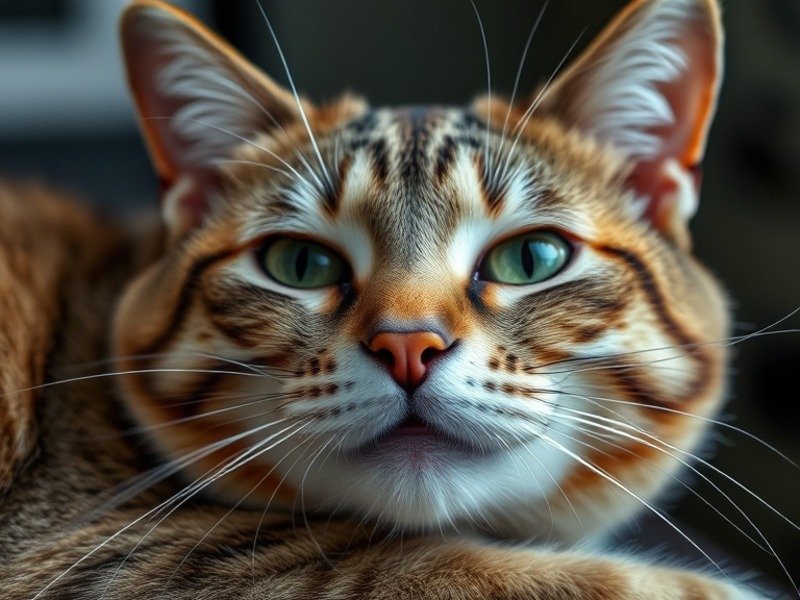Every cat owner wants to see their furry friend happy, healthy, and full of energy. But what happens when your cat starts scratching, sneezing, or experiencing other uncomfortable symptoms? You might find yourself worried, wondering what’s going on and how to help. One common culprit for these symptoms is allergies.
What are Allergies?
Allergies are a common condition in both humans and animals, including cats. They occur when the body’s immune system overreacts to a substance that is usually harmless. This overreaction triggers a cascade of immune responses that can cause a range of symptoms, including:
- Skin Allergies: Skin allergies, also known as atopic dermatitis, are among the most common types of allergies in cats. They occur when the cat’s immune system reacts to allergens in the environment, such as pollen, dust mites, mold, or certain types of grass.
- Food Allergies: Food allergies occur when the cat’s immune system reacts to certain ingredients in their food. Common food allergens include:
- Beef
- Dairy
- Chicken
- Fish
- Soy
- Wheat
- Corn
- Flea Allergies: Flea allergies are a very common problem in cats. Even a single flea bite can trigger a severe allergic reaction, leading to intense itching, scratching, and skin inflammation.
How Allergies Develop
When a cat is exposed to an allergen, their immune system identifies it as a threat and releases histamine and other chemicals that trigger an allergic reaction.
Common Symptoms of Allergies in Cats
Allergies in cats can manifest in a variety of ways, depending on the type of allergy and the severity of the reaction. Here are some common symptoms:
- Itching: Itching, or pruritus, is a common symptom of allergies. Cats may scratch themselves excessively, leading to skin irritation, hair loss, and even open sores.
- Sneezing: Sneezing is a common symptom of allergies that affect the respiratory system, such as allergies to pollen or dust mites.
- Conjunctivitis: Conjunctivitis, or inflammation of the conjunctiva (the membrane that lines the eyelids), is a common symptom of allergies that affect the eyes.
- Discharge: Discharge from the nose, eyes, or ears can occur as a result of allergies.
- Vomiting and Diarrhea: Vomiting and diarrhea are common symptoms of food allergies.
- Skin Lesions: Cats with allergies may develop skin lesions, such as sores, ulcers, or crusty areas.
- Hair Loss: Excessive hair loss can occur due to excessive scratching or licking.
A Case Study: Luna’s Itchy Paws
Luna, a 4-year-old Siamese cat, started experiencing excessive itching, especially on her paws. Her owner, Sarah, noticed that Luna was scratching her paws to the point of drawing blood. “It was heartbreaking to see her so uncomfortable,” Sarah says. “She would spend hours licking and scratching her paws, and she even started losing fur on her legs.”
Sarah took Luna to the vet, and the veterinarian suspected that Luna was suffering from atopic dermatitis, an allergic reaction to something in the environment.
Diagnosing Allergies in Cats
Diagnosing allergies in cats can be a bit challenging, as symptoms can be similar to other conditions. Your veterinarian will perform a thorough physical exam, ask about your cat’s history, and often recommend some additional testing:
- Physical Examination: The veterinarian will examine your cat’s skin, eyes, ears, and nose for any signs of inflammation, discharge, or other abnormalities. They might also check your cat’s lymph nodes for signs of infection or other immune system responses.
- Allergy Testing: Allergy testing, such as intradermal testing or blood tests, can help identify specific allergens.
- Elimination Diet: To identify food allergies, your veterinarian may recommend an elimination diet. This involves switching your cat to a novel protein diet, typically made with ingredients they have never eaten before. If your cat’s symptoms improve, it suggests a food allergy.
- Flea Control: Flea allergies are common in cats. Your veterinarian may recommend a flea control program to eliminate fleas and prevent further reactions.
Treating Allergies in Cats
Treating allergies in cats typically involves a combination of approaches, depending on the type of allergy and the severity of the symptoms.
- Environmental Control: The first step in managing environmental allergies is to try to minimize exposure to the offending allergens. This can include:
- Regular Cleaning: Regularly vacuuming and dusting your home can help reduce dust mites, mold, and other allergens.
- Air Purifiers: Air purifiers can help filter out allergens from the air.
- Washing Bedding: Wash your cat’s bedding regularly in hot water to kill dust mites.
- Medications: Your veterinarian might prescribe various medications to help manage allergy symptoms, including:
- Antihistamines: Antihistamines can help reduce itching and inflammation.
- Corticosteroids: Corticosteroids are potent anti-inflammatory medications that can help reduce itching and inflammation, but they can have side effects.
- Immunomodulators: Immunomodulators can help suppress the immune system’s response to allergens, reducing allergy symptoms.
- Flea Control: Flea control is essential for cats with flea allergies. Talk to your veterinarian about the best flea prevention methods for your cat, such as flea medications, shampoos, or collars.
- Hypoallergenic Diet: If your cat has a food allergy, your veterinarian will recommend a hypoallergenic diet that eliminates the offending ingredient.
A Case Study: Luna’s Allergy Management
Luna, the Siamese cat with atopic dermatitis, responded well to a combination of environmental control and medication. Sarah started vacuuming and dusting her home more frequently, and she also purchased an air purifier. The veterinarian prescribed Luna an antihistamine, which helped to reduce her itching and scratching.
“Luna is doing much better now,” Sarah says. “She still has a bit of itching sometimes, but it’s much less severe. She’s also started to grow her fur back.”
Tips for Living With Allergies in Cats
- Know Your Cat’s Triggers: Identify what triggers your cat’s allergies so you can minimize their exposure.
- Regular Grooming: Regular grooming can help remove allergens from your cat’s coat, reducing the likelihood of allergic reactions.
- Monitor Your Cat’s Symptoms: Pay close attention to your cat’s symptoms and report any changes to your veterinarian.
- Keep Up with Flea Control: Preventative flea control is essential for cats with flea allergies.
- Talk to Your Vet: Consult with your veterinarian about the best approach to managing your cat’s allergies.
Conclusion:
Allergies in cats are a common problem, but they can often be managed with proper care. By understanding the causes and recognizing the symptoms of allergies, you can work with your veterinarian to develop a treatment plan that’s right for your cat. Remember, every cat is unique, and their allergies might require a different approach.
Key Terms:
- Allergies: An overreaction of the body’s immune system to a substance that is usually harmless.
- Atopic Dermatitis: Skin allergies.
- Food Allergies: Allergic reactions to certain ingredients in food.
- Flea Allergies: Allergic reactions to flea bites.
- Antihistamines: Medications that block the action of histamine.
- Corticosteroids: Potent anti-inflammatory medications.
- Immunomodulators: Medications that suppress the immune system’s response to allergens.
Low Competition Keywords:
- Cat allergy symptoms
- Cat allergy treatment
- Cat food allergies
- Cat skin allergies
- Cat flea allergies
- Cat allergy management
Engaging Tone:
- Use realistic, relatable scenarios.
- Focus on the cat’s perspective and their owner’s concerns.
- Use a conversational tone.
Factual Data:
- Include statistics about the prevalence of allergies in cats.
- Share case studies to illustrate the condition and treatment options.
Comprehensive Coverage:
- Address the various causes of allergies.
- Explain the diagnostic process.
- Detail the treatment options.
- Discuss the prognosis.
- Provide tips for prevention.
Visuals:
- Include relevant images to enhance the article’s readability and engagement.


